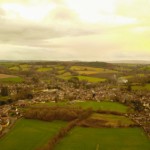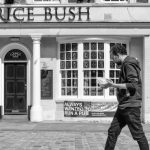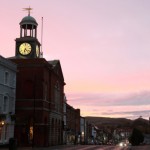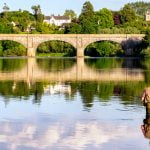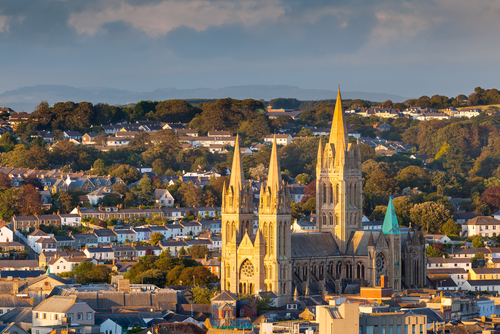
Truro is a small city in southwest England and the county town of Cornwall. The town’s inhabitants are known as Truronians and the name Truro is said to be derived from the Cornish word ‘Tri-ver’, which means three rivers in English. Thus, the Kenwyn, the Allen and the Tinney rivers all meet in Truro, being tributaries of the Truro River. Truro is perhaps best known for being the backdrop to the ‘Poldark‘ books and the BBC’s long-running television series.
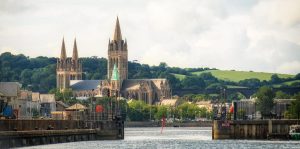
Image: Paul Nash/Shutterstock.com
Truro – A Fleeting History
The archaeological records suggest that the first permanent settlement in the Truro area dates back to Norman times. Around 1140, a small motte and bailey castle was built in the area by Richard de Luci, Chief Justice of England during the reign of Henry II. For his services to the court, he was awarded land in the Truro area.
A settlement grew in the shadow of the castle, which quickly became a successful port, importing goods from overseas. The castle passed to Reginald Fitzroy, an illegitimate son of Henry I, who was invested by King Stephen, as the first Earl of Cornwall. Although the castle was in ruins by 1270, the motte wasn’t flattened until 1840. Today Truro Crown Court stands on the site of the former castle.
In the 14th century Truro’s importance as a port grew, due to its sheltered location, prosperity from fishing, and the growth of the local copper and tin mining industries. However, in the late 14th century, the Black Death brought about mass mortality and an exodus of the remaining population. The town was left in a state of abandonment. Trade gradually returned and the town began to prosper once again in the Tudor period. In 1589, a town charter was granted by Elizabeth I, giving Truro an elected mayor and control over the port of Falmouth.
The Civil War
In 1642, at the start of the Civil War, Truro raised a sizeable army to fight for the king’s forces. A royal mint was established by the royalists to pay the Truro troops. Defeat by the Parliamentarian army came in 1646, forcing the mint to be moved to Exeter. Late in the 17th century, Falmouth was awarded its own charter, meaning Truro lost out on the benefits of control of the local waterways it had enjoyed for a century. This set up a rivalry between the two towns but the dispute was settled in 1709 with control of the River Fal being equally divided between them.
Mining Brings Prosperity

Tin mining was important to Truro in the 18th & 19th century Image:Sakurako/Shutterstock.com
The town’s heyday came in the 18th and 19th centuries, largely due to the mining industry, and in particular the high price of tin. Wealthy mine owners and merchants began to build grand townhouses and country retreats. Truro became the hub for high society in the county, being dubbed by some as “the London of Cornwall”. It’s importance continued to increase throughout the 19th century when iron-smelting works, potteries, and tanneries arrived in the town. The Great Western Railway arrived in the 1860s, providing a direct link to London Paddington.
In 1876 the Diocese of Truro was founded, with the architect John Loughborough Pearson, being chosen to design a cathedral for the town centre. The following year, Queen Victoria granted Truro city status. The foundation stone for the cathedral was laid in 1880, with the building being completed 30 years later, and its three spires being named Victoria, Edward and Alexandra.
20th Century Truro
The start of the 20th century saw a decline in the mining industry, but the city continued to develop as the chief administrative and commercial centre of Cornwall. In 1901, Truro had a population a little over 11,500, but in the next 50 years, it grew slowly, rising to less than 13,000 by 1951.
By the early 1920s, Truro’s quayside had more or less become redundant has ships had generally become larger, meaning they could no longer navigate the river entry at low tide. The quayside area was eventually filled-in and today the area is used for the local farmers’ markets and other outdoor events.
During the WW2, many children were evacuated here, mostly from the London area. They were later joined by large numbers of American troops who were stationed in Truro during preparation and training for the looming D-day invasion of June 1944.
Truro – The Modern Era
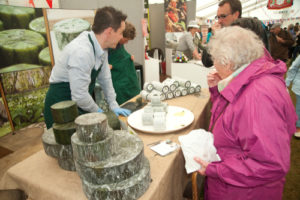
Truro is renowned for its Farmers’ Market mage: Obs70/Shutterstock.com
Today, Truro is Cornwall’s main shopping and retail hub. The pedestrianised town centre is home to the usual collection of high street shops and chain stores. However, there are also plenty of small, independent shops, which are mostly tucked away down the towns narrow back streets. With its central location and good transport links, it makes a great staycation base for exploring the rest of Cornwall. The port is still fairly active and there is also some light industry within the town but a great deal of the town’s economic activity is centred around tourism. This is reflected in the fact that it is home to 18,766 locals according to the 2011 UK census.
It is particularly renowned for its Farmers Market, which was formed in May 1999 as a co-operative of local food producers. The market, supported by the local council, trades in the finest local produce, setting up every Wednesday and Saturday, at the Lemon Quay in the heart of Truro.
Getting there
The Town has good transport links making it one of the most accessible destinations in Cornwall. So you have no excuse for not paying a visit!
By Car
The easiest road route into Cornwall is via the motorway network. First, take the M5 to Exeter, then take the A30 over Bodmin Moor. Truro can then be accessed from A30 at the Carland Cross junction leading on to the A39.
By Train
There are direct train services from London Paddington, South Wales and Scotland to Truro. There’s also a sleeper service from London Paddington.
By Bus
National Express offers scheduled coach services to the town from many locations across the UK.
By Air
The nearest airport is Newquay, which is 20 miles away. The next nearest regional airport is Exeter, which is 87 miles away. Bristol is the nearest large international airport and situated 156 miles away.
Did you know?
- Truro is the only city in Cornwall and the southernmost in mainland Britain.
- It has one of the most recently constructed cathedrals in the UK, having being completed in 1910.
- Inspired by the original, there is a ‘Truro’ in Nova Scotia, Canada one in South Australia and two in the USA at Iowa and Massachusetts.
- Truro is twinned with Boppard in the Rhineland-Palatinate region of Germany and Morlaix in Brittany, France.
Things to see and do in Truro!
- ShelterBox Visitor Centre – gives a unique insight into the charity’s work into responding to natural disasters around the world.
- Truro Bowl – eight-lane bowling alley with a ninety-seat restaurant.
- Royal Cornwall Museum – county’s oldest museum, housing important collections of natural history, geology, decorative arts and paintings
- Truro Cathedral – built in the 1880s, it is the only one in Cornwall currently. It has an impressive has a 250ft high spire too!
- Healeys Cornish Cyder – establishment that produces traditional scrumpy, ciders, wines, brandy, jams and preserves, etc. and also has lots of friendly farm animals
- Enys Gardens – 30 acres of formal gardens, open meadow and woodland, dating back to the early 1700s
- Bosvigo Garden – Georgian house surrounded by fine gardens, featuring topiary and original Victorian conservatory, with small woodland area and nursery
- Tregothnan House – extending over 40 hectares, it is the largest historic garden in Cornwall, featuring a highly regarded botanical collection
Where to Stay in Truro?
Truro is a great base for exploring the rest of Cornwall. Accommodation options range from city centre hotels to family farm bed and breakfast places and from self-catering cottages to some of the best campsites in the UK. Thus, if you’re looking for somewhere to stay, there’s something to suit all tastes and budgets. A broad indication of prices for the most common types of available accommodation are:
Campsites: £20 – £30 pppn
B & B/Guesthouses: £60 – £80
Standard Hotels/Inns £80 – £100
3/4/5 Star Hotels £100 – £200
The Truro Quiz


